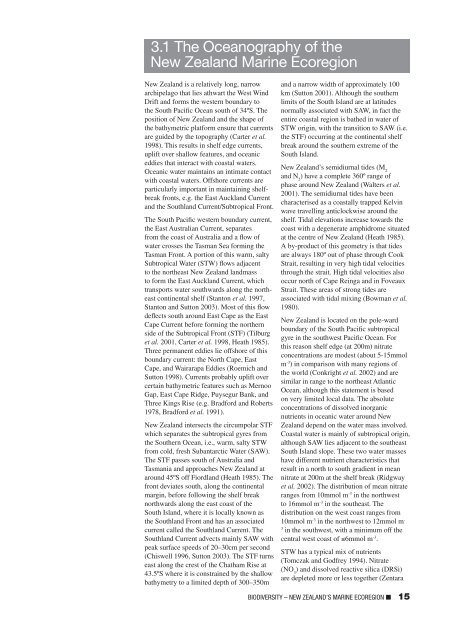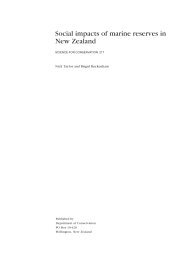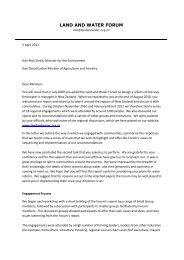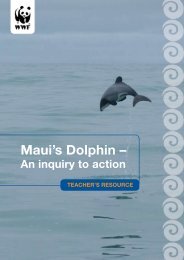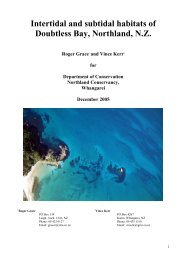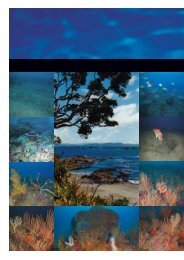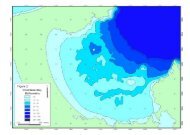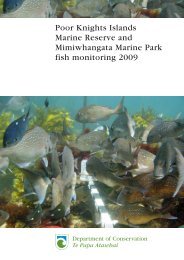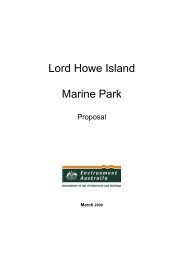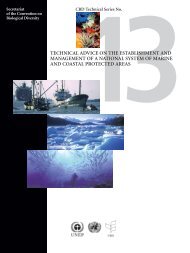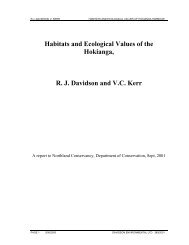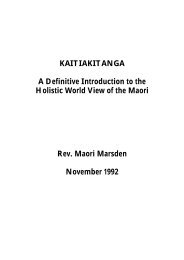WWF Shining a spotlight on the biodiversity of ... - MarineNZ.org.nz
WWF Shining a spotlight on the biodiversity of ... - MarineNZ.org.nz
WWF Shining a spotlight on the biodiversity of ... - MarineNZ.org.nz
You also want an ePaper? Increase the reach of your titles
YUMPU automatically turns print PDFs into web optimized ePapers that Google loves.
3.1 The Oceanography <strong>of</strong> <strong>the</strong><br />
New Zealand Marine Ecoregi<strong>on</strong><br />
New Zealand is a relatively l<strong>on</strong>g, narrow<br />
archipelago that lies athwart <strong>the</strong> West Wind<br />
Drift and forms <strong>the</strong> western boundary to<br />
<strong>the</strong> South Pacific Ocean south <strong>of</strong> 34ºS. The<br />
positi<strong>on</strong> <strong>of</strong> New Zealand and <strong>the</strong> shape <strong>of</strong><br />
<strong>the</strong> bathymetric platform ensure that currents<br />
are guided by <strong>the</strong> topography (Carter et al.<br />
1998). This results in shelf edge currents,<br />
uplift over shallow features, and oceanic<br />
eddies that interact with coastal waters.<br />
Oceanic water maintains an intimate c<strong>on</strong>tact<br />
with coastal waters. Offshore currents are<br />
particularly important in maintaining shelfbreak<br />
fr<strong>on</strong>ts, e.g. <strong>the</strong> East Auckland Current<br />
and <strong>the</strong> Southland Current/Subtropical Fr<strong>on</strong>t.<br />
The South Pacific western boundary current,<br />
<strong>the</strong> East Australian Current, separates<br />
from <strong>the</strong> coast <strong>of</strong> Australia and a flow <strong>of</strong><br />
water crosses <strong>the</strong> Tasman Sea forming <strong>the</strong><br />
Tasman Fr<strong>on</strong>t. A porti<strong>on</strong> <strong>of</strong> this warm, salty<br />
Subtropical Water (STW) flows adjacent<br />
to <strong>the</strong> nor<strong>the</strong>ast New Zealand landmass<br />
to form <strong>the</strong> East Auckland Current, which<br />
transports water southwards al<strong>on</strong>g <strong>the</strong> nor<strong>the</strong>ast<br />
c<strong>on</strong>tinental shelf (Stant<strong>on</strong> et al. 1997,<br />
Stant<strong>on</strong> and Sutt<strong>on</strong> 2003). Most <strong>of</strong> this flow<br />
deflects south around East Cape as <strong>the</strong> East<br />
Cape Current before forming <strong>the</strong> nor<strong>the</strong>rn<br />
side <strong>of</strong> <strong>the</strong> Subtropical Fr<strong>on</strong>t (STF) (Tilburg<br />
et al. 2001, Carter et al. 1998, Heath 1985).<br />
Three permanent eddies lie <strong>of</strong>fshore <strong>of</strong> this<br />
boundary current: <strong>the</strong> North Cape, East<br />
Cape, and Wairarapa Eddies (Roemich and<br />
Sutt<strong>on</strong> 1998). Currents probably uplift over<br />
certain bathymetric features such as Mernoo<br />
Gap, East Cape Ridge, Puysegur Bank, and<br />
Three Kings Rise (e.g. Bradford and Roberts<br />
1978, Bradford et al. 1991).<br />
New Zealand intersects <strong>the</strong> circumpolar STF<br />
which separates <strong>the</strong> subtropical gyres from<br />
<strong>the</strong> Sou<strong>the</strong>rn Ocean, i.e., warm, salty STW<br />
from cold, fresh Subantarctic Water (SAW).<br />
The STF passes south <strong>of</strong> Australia and<br />
Tasmania and approaches New Zealand at<br />
around 45ºS <strong>of</strong>f Fiordland (Heath 1985). The<br />
fr<strong>on</strong>t deviates south, al<strong>on</strong>g <strong>the</strong> c<strong>on</strong>tinental<br />
margin, before following <strong>the</strong> shelf break<br />
northwards al<strong>on</strong>g <strong>the</strong> east coast <strong>of</strong> <strong>the</strong><br />
South Island, where it is locally known as<br />
<strong>the</strong> Southland Fr<strong>on</strong>t and has an associated<br />
current called <strong>the</strong> Southland Current. The<br />
Southland Current advects mainly SAW with<br />
peak surface speeds <strong>of</strong> 20–30cm per sec<strong>on</strong>d<br />
(Chiswell 1996, Sutt<strong>on</strong> 2003). The STF turns<br />
east al<strong>on</strong>g <strong>the</strong> crest <strong>of</strong> <strong>the</strong> Chatham Rise at<br />
43.5ºS where it is c<strong>on</strong>strained by <strong>the</strong> shallow<br />
bathymetry to a limited depth <strong>of</strong> 300–350m<br />
and a narrow width <strong>of</strong> approximately 100<br />
km (Sutt<strong>on</strong> 2001). Although <strong>the</strong> sou<strong>the</strong>rn<br />
limits <strong>of</strong> <strong>the</strong> South Island are at latitudes<br />
normally associated with SAW, in fact <strong>the</strong><br />
entire coastal regi<strong>on</strong> is ba<strong>the</strong>d in water <strong>of</strong><br />
STW origin, with <strong>the</strong> transiti<strong>on</strong> to SAW (i.e.<br />
<strong>the</strong> STF) occurring at <strong>the</strong> c<strong>on</strong>tinental shelf<br />
break around <strong>the</strong> sou<strong>the</strong>rn extreme <strong>of</strong> <strong>the</strong><br />
South Island.<br />
New Zealand’s semidiurnal tides (M 2<br />
and N 2<br />
) have a complete 360º range <strong>of</strong><br />
phase around New Zealand (Walters et al.<br />
2001). The semidiurnal tides have been<br />
characterised as a coastally trapped Kelvin<br />
wave travelling anticlockwise around <strong>the</strong><br />
shelf. Tidal elevati<strong>on</strong>s increase towards <strong>the</strong><br />
coast with a degenerate amphidrome situated<br />
at <strong>the</strong> centre <strong>of</strong> New Zealand (Heath 1985).<br />
A by-product <strong>of</strong> this geometry is that tides<br />
are always 180º out <strong>of</strong> phase through Cook<br />
Strait, resulting in very high tidal velocities<br />
through <strong>the</strong> strait. High tidal velocities also<br />
occur north <strong>of</strong> Cape Reinga and in Foveaux<br />
Strait. These areas <strong>of</strong> str<strong>on</strong>g tides are<br />
associated with tidal mixing (Bowman et al.<br />
1980).<br />
New Zealand is located <strong>on</strong> <strong>the</strong> pole-ward<br />
boundary <strong>of</strong> <strong>the</strong> South Pacific subtropical<br />
gyre in <strong>the</strong> southwest Pacific Ocean. For<br />
this reas<strong>on</strong> shelf edge (at 200m) nitrate<br />
c<strong>on</strong>centrati<strong>on</strong>s are modest (about 5-15mmol<br />
m -3 ) in comparis<strong>on</strong> with many regi<strong>on</strong>s <strong>of</strong><br />
<strong>the</strong> world (C<strong>on</strong>kright et al. 2002) and are<br />
similar in range to <strong>the</strong> nor<strong>the</strong>ast Atlantic<br />
Ocean, although this statement is based<br />
<strong>on</strong> very limited local data. The absolute<br />
c<strong>on</strong>centrati<strong>on</strong>s <strong>of</strong> dissolved in<strong>org</strong>anic<br />
nutrients in oceanic water around New<br />
Zealand depend <strong>on</strong> <strong>the</strong> water mass involved.<br />
Coastal water is mainly <strong>of</strong> subtropical origin,<br />
although SAW lies adjacent to <strong>the</strong> sou<strong>the</strong>ast<br />
South Island slope. These two water masses<br />
have different nutrient characteristics that<br />
result in a north to south gradient in mean<br />
nitrate at 200m at <strong>the</strong> shelf break (Ridgway<br />
et al. 2002). The distributi<strong>on</strong> <strong>of</strong> mean nitrate<br />
ranges from 10mmol m -3 in <strong>the</strong> northwest<br />
to 16mmol m -3 in <strong>the</strong> sou<strong>the</strong>ast. The<br />
distributi<strong>on</strong> <strong>on</strong> <strong>the</strong> west coast ranges from<br />
10mmol m -3 in <strong>the</strong> northwest to 12mmol m -<br />
3<br />
in <strong>the</strong> southwest, with a minimum <strong>of</strong>f <strong>the</strong><br />
central west coast <strong>of</strong> ≤6mmol m -3 .<br />
STW has a typical mix <strong>of</strong> nutrients<br />
(Tomczak and Godfrey 1994). Nitrate<br />
(NO 3<br />
) and dissolved reactive silica (DRSi)<br />
are depleted more or less toge<strong>the</strong>r (Zentara<br />
BIODIVERSITY – NEW ZEALAND’S MARINE ECOREGION ■ 15


